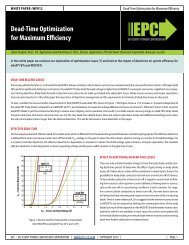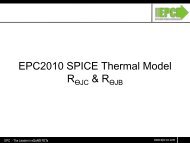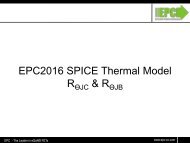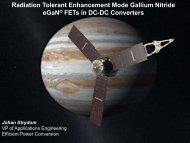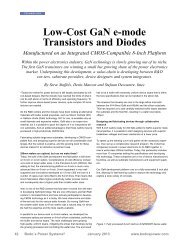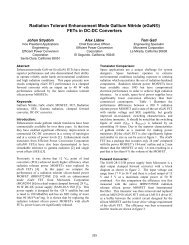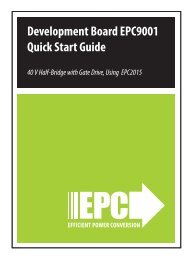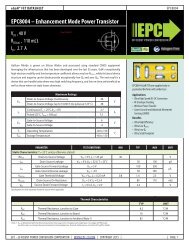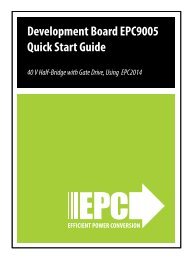application switching
Selecting eGaN® FET Optimal On-Resistance - EPC
Selecting eGaN® FET Optimal On-Resistance - EPC
- No tags were found...
Create successful ePaper yourself
Turn your PDF publications into a flip-book with our unique Google optimized e-Paper software.
WHITE PAPER: WP011<br />
Selecting eGaN® FET Optimal On-Resistance<br />
Effect of Package and Layout on Optimization<br />
It has been shown [9, 10, 11] that common source inductance (CSI) will significantly<br />
increase <strong>switching</strong> loss for hard <strong>switching</strong> devices. Equations for the<br />
estimation of this increase are complex and somewhat varied. This loss increase,<br />
although significant has also been shown to be die size independent<br />
for a given device technology [12] and therefore has little impact on die size<br />
optimization process. For eGaN FETs in practice, however, the CSI would be a<br />
weak function of die size as all the wafer level chip-scale package (WLCSP) inductances<br />
will scale with die size, but this complexity is beyond the scope of<br />
this paper. Such an inverse relationship between CSI and die size means that<br />
some small portion of <strong>switching</strong> losses actually decreases with increasing die<br />
size, even though this may seems counter intuitive.<br />
Optimum Die Resistance (mΩ)<br />
100<br />
10<br />
eGaN FET<br />
MOSFET<br />
Summary<br />
Using the simple optimization method presented here is a quick way to find the<br />
optimum eGaN FET on-resistance value. As with many simple solutions, the accuracy<br />
is limited and the actual optimum resistance may deviate. Furthermore,<br />
the optimum combination of die size and on-resistance is also a function of<br />
the non-device related equivalent circuit conduction resistance. This paper<br />
presents a method for optimization that compensates for these additional current-dependent<br />
losses. Experimental results show good agreement through<br />
accurate predictions of load current at peak efficiency.<br />
Since eGaN FETs will always optimize to a lower on-resistance than MOSFETs,<br />
the overall peak efficiency will therefore be higher (total conduction and<br />
<strong>switching</strong> losses equal at peak) than MOSFETs (given the assumptions made).<br />
If the same on-resistance is used, the eGaN FET efficiency will peak at a lower<br />
current.<br />
Optimum Die Resistance (mΩ)<br />
100<br />
10<br />
0 5 10 15 20 25 30 35<br />
Load Current (A)<br />
Figure 6: Optimum on-resistance (25 °C) for the control FET (high side)<br />
Figure 6: Optimum on-resistance (25 °C) for the control FET (high side)<br />
for a 45 V to 22 V / 1 MHz buck converter.<br />
for a 45 V to 22 V / 1 MHz buck converter.<br />
eGaN FET<br />
MOSFET - Q RR<br />
MOSFET<br />
0 5 10 15 20 25 30 35<br />
Load Current (A)<br />
Figure 7: Optimum on-resistance (25 °C) for the synchronous FET (low side)<br />
Figure 7: Optimum on-resistance (25 °C) for the synchronous FET (low side)<br />
for a 45 V to 22 V / 1 MHz buck converter.<br />
for a 45 V to 22 V / 1 MHz buck converter.<br />
References:<br />
[1] J. Strydom, “eGaN® FET-Silicon Power Shoot-Out Part 1: Comparing Figure of Merit (FOM)”, Power Electronics Technology, Sept. 2010,<br />
http://powerelectronics.com/power_semiconductors/power_mosfets/fom-useful-method-compare-201009/<br />
[2] J. Strydom, “The eGaN FET-Silicon Power Shoot-Out: 2: Drivers, Layout”, Power Electronics Technology, Jan. 2011,<br />
http://powerelectronics.com/power_semiconductors/first-article-series-gallium-nitride-201101/<br />
[3] Jon, Klein, “Synchronous buck MOSFET loss calculations with Excel model”, Fairchild Semiconductor, App. note AN-6005, http://www.fairchildsemi.com/an/AN/AN-6005.pdf<br />
[4] Jon Gladish, “MOSFET Selection to Minimize Losses in Low-Output-Voltage DC-DC Converters”, Fairchild Semiconductor Power Seminar 2008 – 2009.<br />
[5] “Properly Sizing MOSFETs for PWM Controllers”, Sipex App. note ANP-20, http://www.exar.com/common/content/document.ashx?id=1245<br />
[6] J. Strydom, “eGaN® FET- Silicon Power Shoot-Out Volume 8: Envelope Tracking”, Power Electronics Technology, Apr. 2012,<br />
http://powerelectronics.com/power_semiconductors/gan_transistors/egan-fet-silicon-power-shoot-out-volume-8-0430/<br />
[7] EPC2001 datasheet, EPC Corporation, http://epc-co.com/epc/Products/eGaNFETs/EPC2001.aspx<br />
[8] EPC2016 datasheet, EPC Corporation, http://epc-co.com/epc/Products/eGaNFETs/EPC2016.aspx<br />
[9] D. Jauregui, B. Wang, R. Chen, “Power Loss Calculation with Common Source Inductance Consideration for Synchronous Buck Converters”, Texas Instruments, SLPA009A, June 2011,<br />
http://www.ti.com/lit/an/slpa009a/slpa009a.pdf<br />
[10] W. Eberle, Z. Zhang, et. al, “A Practical Switching Loss Model for Buck Voltage Regulators”, IEEE Transactions on Power Electronics, Vol. 24, No. 3, March 2009.<br />
[11] T. Hashimoto, M. Shiraishi, et. al, “System in Package (SiP) With Reduced Parasitic Inductance for Future Voltage Regulator”, IEEE Transactions on Power Electronics, Vol. 24, No. 6, June 2009.<br />
[12] Y. Ying, “Device Selection Criteria - Based on Loss Modeling and Figure of Merit”, M.Sc. Thesis, Virginia Tech, http://scholar.lib.vt.edu/theses/available/etd-05272008-143141/<br />
EPC – EFFICIENT POWER CONVERSION CORPORATION | WWW.EPC-CO.COM | COPYRIGHT 2013 | | PAGE 7



